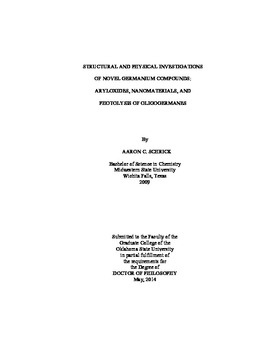| dc.contributor.advisor | Weinert, Charles S. | |
| dc.contributor.author | Schrick, Aaron C. | |
| dc.date.accessioned | 2015-06-17T20:07:53Z | |
| dc.date.available | 2015-06-17T20:07:53Z | |
| dc.date.issued | 2014-05 | |
| dc.identifier.uri | https://hdl.handle.net/11244/15105 | |
| dc.description.abstract | The work described in this dissertation will explore the synthesis and characterization of novel germanium containing compounds in order to gain a better understanding of the organometallic chemistry of germanium. These compounds include germanium bisamides, aryloxogermylenes, polyfunctional aryloxides such as calix[n]arenes and binaphthoxogermanium compounds, and oligogermanes containing up to four germanium atoms. | |
| dc.description.abstract | We have found that the germanium bisamides can be trapped using the germylene trapping agent benzil and we have fully characterized those products. The germanium bisamides can also be used as starting materials to synthesize germanium aryloxides via protonolysis of a phenol that contains one or more phenolic groups. Using this method we have prepared the germanium(IV) aryloxides [Ge(OC6H3Ph2-2,6)2(R)(I)] (R = But or Me) where the R = Me derivative was then converted to the triaryloxo species [Ge(OC6H3Ph2-2,6)3(Me)] upon reaction of the iodine containing compound with an extra equivalent of 2,6-diphenylphenol. Using polyfunctional phenols, we prepared and characterized the germanium(II) calix[5]arene complex {calix[5]arene}2Ge2(OSiMe3)4(OH)2, the calix[6]arene complex [(C6H3)6(CH2)6(OSiMe2Ph)6], and the binaphthoxogermanium(II) complex (S,S)-[Ge{OC20H10(OSiMe2Ph)-2'-(SiMe3)2-3,3'}2]. | |
| dc.description.abstract | Chapter five describes the synthesis of a series of three oligogermanes including a digermane, a trigermane, and a branched neopentyl germane. We have found that these oligogermanes can be used as precursors for the preparation of germanium(0) nanomaterials, and that the size of the resulting nanoparticles correlates with the number of catenated germanium atoms in the precursor compounds. These nanoparticles are fluorescent and the position of the emission maximum is red shifted as the size of the particles increases. | |
| dc.description.abstract | Lastly, the sixth chapter will discuss the synthesis, characterization, and photochemistry of a series of six linear oligogermanes. The optical and electronic properties of these compounds were probed using UV/visible spectroscopy and differential pulse voltammetry. The photochemistry of these compounds will be analyzed by photolyzing each compound using UV-C light (280-100 nm) in the presence of acetic acid as a germylene trapping agent. If germylenes :GeR2 are formed, they should be trapped to yield R2Ge(H)OAc. The photolysis products will be characterized by NMR (1H and 13C) spectroscopy, infrared spectroscopy (FTIR), and gas-chromatography mass spectroscopy (GC/MS). | |
| dc.format | application/pdf | |
| dc.language | en_US | |
| dc.rights | Copyright is held by the author who has granted the Oklahoma State University Library the non-exclusive right to share this material in its institutional repository. Contact Digital Library Services at lib-dls@okstate.edu or 405-744-9161 for the permission policy on the use, reproduction or distribution of this material. | |
| dc.title | Structural and physical investigations of novel germanium compounds: Aryloxides, nanomaterials, and photolysis of oligogermanes | |
| dc.contributor.committeeMember | Apblett, Allen | |
| dc.contributor.committeeMember | Materer, Nicholas | |
| dc.contributor.committeeMember | Bunce, Richard A. | |
| dc.contributor.committeeMember | Veenstra, John N. | |
| osu.filename | Schrick_okstate_0664D_13249.pdf | |
| osu.accesstype | Open Access | |
| dc.type.genre | Dissertation | |
| dc.type.material | Text | |
| dc.subject.keywords | aryloxides | |
| dc.subject.keywords | germanium | |
| dc.subject.keywords | hydrogermolysis | |
| dc.subject.keywords | oligogermanes | |
| thesis.degree.discipline | Chemistry | |
| thesis.degree.grantor | Oklahoma State University | |
